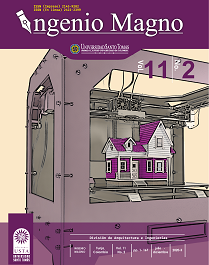Characterization of the pyrolysis process of expanded polystyrene waste
Main Article Content
Abstract
Downloads
Article Details
DECLARATION OF ORGINIALITY OF SUBMITTED ARTICLE
With this document, I/We certify that the article submitted for possible publication in the institutional journal INGENIO MAGNO of the Research Center Alberto Magno CIIAM of the University Santo Tomás, Tunja campus, is entirely of my(our) own writing, and is a product of my(our) direct intellectual contribution to knowledge.
All data and references to completed publications are duly identified with their respective bibliographical entries and in the citations thus highlighted. If any adjustment or correction is needed, I(we) will contact the journal authorities in advance.
Due to that stated above, I(we) declare that the entirety of the submitted material is in accordance with applicable laws regarding intellectual and industrial property, and therefore, I(we) hold myself(ourselves) responsible for any complaint related to it.
If the submitted article is published, I(we) declare that I(we) fully relinquish publishing rights of the article to the University Santo Tomás, Tunja campus. As remuneration for this relinquishment of rights, I(we) declare my(our) agreement to receive two (2) copies of the edition of the journal in which my(our) article appears.
References
Y. Zhang, D. Duan, H. Lei, E. Villota and R. Ruan, “Jet fuel production from waste plastics via catalytic pyrolysis
with activated carbons,” Applied Energy, vol. 251, pp. 1-17, 2019.
N. Sophonrat, L. Sandström, I. N. Zaini and W. Yang, “Stepwise pyrolysis of mixed plastics and paper for
separation of oxygenated and hydrocarbon condensates,” Applied Energy, vol. 229, pp. 314-325, 2018.
S. M. FakhrHoseini and M. Dastanian, “Predicting Pyrolysis Products of PE, PP and PET Using NRTL Activity Coefficient Model,” Hindawi Journal of Chemistry, pp. 1-5, 2013.
S. D. A. Sharuddin, F. Abnisa, W. M. A. W. Daud and M. K. Aroua, “A review on pyrolysis of plastic wastes,” Energy
Conversion and Management, vol. 115, pp. 308-326, 2016.
A. Sobko, “Generalized Van der Waals-Berthelot equation of state,” Doklady Physics, vol. 53, no. 8, pp. 416-
419, 2008.
J. A. Onwundili, N. Insura and P. Williams, “Composition of products from the pyrolysis of polyethylene
and polystyrene in a closed batch reactor: Effects of temperature and residence time,” Journal of Analytical
and Applied Pyrolysis, vol. 86, no. 2, pp. 293-303, 2009.
L. Quesada, M. Calero, M. Martín-Lara, A. Pérez and G. Blázquez, “Characterization of fuel produced by pyrolysis of plasticfilm obtained of municipal solid waste,” Energy, vol. 186, pp. 1-9, 2019.
S. M. Al-Salem, “Thermal pyrolysis of high density polyethylene (HDPE) in a novel fixed bed reactor system for
the production of high value gasoline range hydrocarbons (HC),” Process Safety and Enviromental Protection,
vol. 127, pp. 171-179, 2019.
J.-L. Shie, J.-P. Lin, C.-Y. Chang, D.-J. Lee and C.-H. Wu, “Pyrolysis of oil sludge with additives of sodium and potassium compounds,” Resources, Conservation and Recycling, vol. 39, no. 1, pp. 51-64, 2003.
J. Zhou, Y. Qiao, W. Wang, E. Leng, J. Huang, Y. Yu and M. Xu, “Formation of styrene monomer, dimer and trimer in
the primary volatiles produced from polystyrene pyrolysis in a wire-mesh reactor,” Fuel, vol. 182, pp. 333-339,
2016.
T. Faravelli, M. Pinciroli, F. Pisano, G. Bozzano, M. Dente and E. Ranzi, “Thermal degradation of polystyrene,”
Journal of Analytical and Applied Pyrolysis, vol. 60, no. 1, pp. 103-121, 2001.
I. C. McNeill, M. Zulfiqar and T. Kousar, “A detailed investigation of the products of the thermal degradation
of polystyrene,” Polymer Degradation and Stability, vol. 28, no. 2, pp. 131-151, 1990.
M. Artetxe, G. Lopez, M. Amutio, I. Barbarias, A. Arregi, R. Aguado, J. Bilbao and M. Olazar, “Styrene recovery from polystyrene by flash pyrolysis in a conical spouted bed reactor,” Waste Management, vol. 45, pp. 126-133, 2015.
S. I. Moqadam, M. Mirdrikvand, B. Roozbehani, A. Kharaghani and M. R. Shishehsaz, “Polystyrene pyrolysis using
silica-alumina catalyst in fluidized bed reactor,” Clean Techn Environ Policy, vol. 17, pp. 1847-1860, 2015.
A. Demirbas, “Pyrolysis of municipal plastic wastes for recovery of gasolinerange hydrocarbons,” Journal of
Analytical and Applied Pyrolysis, vol. 72, no. 1, pp. 97-102, 2004.
Y. Liu, J. Qian and J. Wang, “Pyrolysis of polystyrene waste in a fluidized-bed reactor to obtain styrene monomer
and gasoline fraction,” Fuel Processing Technology, vol. 63, no. 1, pp. 45-55, 2000.
A. Karaduman, E. Simsek, B. Cicek and A. Y. Bilgesü, “Flash pyrolysis of polystyrene wastes in a free-fall reactor under vacuum,” Journal of Analytical and Applied Pyrolysis, vol. 60, no. 2, pp. 179-186, 2001.
PlasticsEurope, “Reciclado y Recuperación de energía,” 2019. [Online]. Available: https://www.plasticseurope.org/es/focus-areas/circular-economy/zero-plasticslandfill/recycling-and-energyrecovery.
P. T. Williams and E. Slaney, “Analysis of products from the pyrolysis and liquefaction single plastics and
waste plastic mixtures,” Resources, Conservation and Recycling, vol. 51, no. 4, pp. 754-769, 2007.

